
Rounders is a bat-and-ball game played between two teams. Rounders is a striking and fielding team game that involves hitting a small, hard, leather-cased ball with a wooden, plastic, or metal bat that has a rounded end. The players score by running around the four bases on the field.

Softball is a popular variation of baseball, the difference being that it is played with a larger ball, on a smaller field, and with only underhand pitches permitted. Softball is played competitively at club levels, the college level, and the professional level. The game was first created in 1887 in Chicago by George Hancock.

Tee-ball is a team sport based on a simplified form of baseball or softball. It is intended as an introduction for children to develop bat-and-ball game skills and have fun.
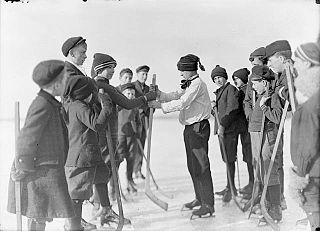
Shinny is an informal type of hockey played on ice. It is also used as another term for street hockey. There are no formal rules or specific positions, and often, there are no goaltenders. The goal areas at each end may be marked by nets, or simply by objects, such as stones or blocks of snow. Body checking and lifting or "roofing/reefing/raising the puck" are often forbidden because the players are not wearing protective equipment. Shinny is a game that all levels of hockey enthusiasts can play because it requires no rink, requires no skills except ability to hold a stick and at the very least to try to touch the puck or ball when it goes by. Shinny may be completely non-competitive and recreational.
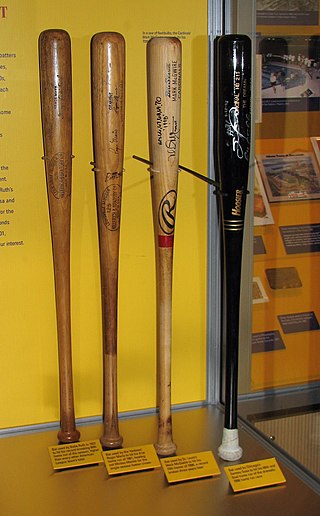
A baseball bat is a smooth wooden or metal club used in the sport of baseball to hit the ball after it is thrown by the pitcher. By regulation it may be no more than 2.61 inches (6.6 cm) in diameter at the thickest part and no more than 42 inches (1.067 m) in length. Although historically bats approaching 3 pounds (1.4 kg) were swung, today bats of 33 ounces (0.94 kg) are common, topping out at 34 to 36 ounces.

Kickball is a team sport and league game, similar to baseball. Like baseball, it is a safe haven game in which one team tries to score by having its players return a ball from home base to the field and then circle the bases. Meanwhile, the other team tries to stop them by tagging them "out" with the ball before they can return to home base. However, instead of hitting a small, hard ball with a bat, players kick an inflated rubber ball; this makes it more accessible to young children. As in baseball, teams alternate half-innings. The team with the most runs after a predefined number of innings wins.

In baseball, batting is the act of facing the opposing pitcher and trying to produce offense for one's team. A batter or hitter is a person whose turn it is to face the pitcher. The three main goals of batters are to become a baserunner, to drive runners home or to advance runners along the bases for others to drive home, but the techniques and strategies they use to do so vary. Hitting uses a motion that is virtually unique to baseball and its fellow bat-and-ball sports, one that is rarely used in other sports. Hitting is unique because it involves rotating in the horizontal plane of movement, unlike most sports movements which occur in the vertical plane.

Pesäpallo is a fast-moving bat-and-ball sport that is often referred to as the national sport of Finland and has some presence in other places including Germany, Sweden, Switzerland, Australia, and Canada's northern Ontario. It is similar to brännboll, rounders, lapta, and baseball.

Wiffle ball is a scaled back variation of baseball that was developed in 1953 in Fairfield, Connecticut. Originally, it was intended to be played in confined space or otherwise small area, but became a popular outdoor activity. The sport is played using a perforated light-weight plastic ball and a long hollow plastic bat. Two teams of one to five players each attempt to advance imaginary runners to home plate, and score, based on where each batter places the ball on the field. The term Wiffle ball may refer to the sport as a whole, or the ball used in the sport. Wiffle is a registered trademark of Wiffle Ball, Inc. and was derived from the slang word whiff meaning to strike out.

The Northwoods League is a collegiate summer baseball wooden bat league. All players in the league must have NCAA eligibility remaining in order to participate. The league is amateur, and players are not paid, so as to maintain their college eligibility. Graduated senior pitchers are also eligible to play in the Northwoods League. Each team may have four of these players at a time.

Brännboll, known as rundbold in Denmark, Brennball in Germany, and sharing the names slåball and brentball with longball in Norway, is a bat-and-ball game similar to longball, played at amateur level throughout Sweden, Finland, Norway, Denmark and Germany. The game is mostly played on fields, sports grounds, and in public parks, but it is also part of the PE curriculum in some areas. The name is derived from the act of catching a player between two bases at the end of a batting round, referred to as "burning" them (bränna), roughly equivalent to being run out in cricket or out in baseball. The world championship, called Brännbollscupen, is an annual event in the Swedish city of Umeå.

The Sandlot is a 1993 American coming-of-age sports comedy film co-written, directed, and narrated by David Mickey Evans. It tells the story of a group of young baseball players during the summer of 1962. It stars Tom Guiry, Mike Vitar, Karen Allen, Denis Leary, Marty York, and James Earl Jones. The movie is set in the San Fernando Valley in Los Angeles, CA and the filming locations were in Midvale, Salt Lake City, and Ogden, Utah. It grossed $34 million worldwide and has since become a cult film.
Keep Away, also called Monkey in the Middle, Piggy in the Middle, Pickle in a Dish, or Pickle in the Middle, or Monkey, is a children's game in which two or more players must pass a ball to one another, while another player attempts to intercept it. The game could be considered a reverse form of circle dodgeball, because instead of trying to hit people in the middle with the ball, players attempt to keep the ball away from them. The game is played worldwide.
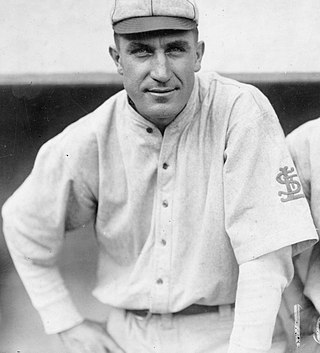
Edward Joseph Konetchy, nicknamed "Big Ed" and "the Candy Kid", was an American first baseman in Major League Baseball for a number of teams, primarily in the National League, from 1907 to 1921. He played for the St. Louis Cardinals (1907–1913), Pittsburgh Pirates (1914), Pittsburgh Rebels of the Federal League (1915), Boston Braves (1916–1918), Brooklyn Robins (1919–1921), and Philadelphia Phillies (1921). He batted and threw right-handed.

Dusty Diamond's All-Star Softball is a one- or two-player NES video game where players can select various fictional softball players and customize their own team to take to the championship.
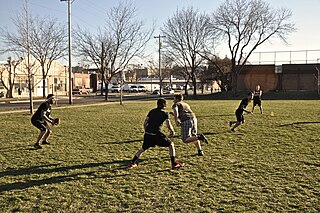
Street football, also known as backyard football or sandlot football, is an amateur variant of American football primarily played informally by youth. It features far less equipment and fewer rules than its counterparts and, unlike the similar touch football, features full tackling.
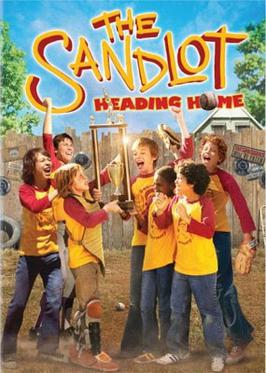
The Sandlot: Heading Home, is a 2007 American science fiction sports comedy film directed by William Dear and starring Luke Perry, Danny Nucci and Sarah Deakins. It is the third installment in The Sandlot franchise and a sequel to The Sandlot 2 (2005). It was released direct-to-video on May 1, 2007.

Baseball Canada is the national governing body for baseball in Canada. They are members of the Canadian Olympic Committee and the World Baseball Softball Confederation.
Alternative Baseball, officially Alternative Baseball Organization Inc. (ABO), is an American 501(c)(3) nonprofit organization based in Dallas, Georgia, United States. Providing year-round baseball training, exhibitions, and activities for teens and adults with autism and other disabilities throughout the United States.

In sports, the term diamond sports refers to recreational variantsof baseball, a bat-and-ball sport. The most popular and closely related sport to baseball is softball, with the two sports being administered internationally by the World Baseball Softball Confederation (WBSC), alongside Baseball5.

















